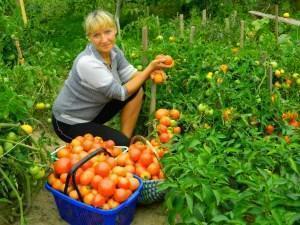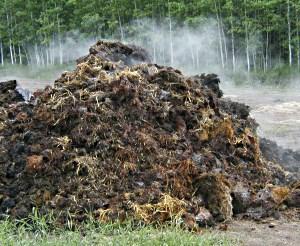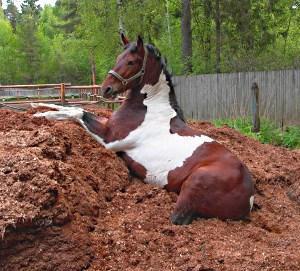Manure as organic fertilizer in the country
 To obtain a good harvest in a summer cottage, soil with high biological activity is needed. What do I need to do? The summer resident is only required to make organic fertilizersso that soil animals can develop comfortably in the soil. The best food for the inhabitants of the soil is considered to be fertilizer made from cow, horse, pig and rabbit manure.
To obtain a good harvest in a summer cottage, soil with high biological activity is needed. What do I need to do? The summer resident is only required to make organic fertilizersso that soil animals can develop comfortably in the soil. The best food for the inhabitants of the soil is considered to be fertilizer made from cow, horse, pig and rabbit manure.
Do I need manure at their summer cottage

Manure from various animals, rotted leaves and grass are used as fertilizers. The basic rule of the gardener and gardener is to apply fertilizer correctly, taking into account the type of soil and the requirements of the plants.
Types of manure used
Horse dung
 The high nutrient content and excellent heat and decomposition properties make horse manure the best fertilizer used in the garden.
The high nutrient content and excellent heat and decomposition properties make horse manure the best fertilizer used in the garden.
The use of horse manure as fertilizer improves the quality of the soil:
- the amount of carbon dioxide in the soil increases significantly;
- optimal thermal, water and air conditions are created;
- the physical and chemical composition is becoming much better;
- loosening of clay soil is observed;
- beneficial microorganisms become more active;
- sandy soils retain moisture better.
Horse manure is good for feeding cucumbers, potatoes, zucchini, cabbage, pumpkin and other vegetables. It is especially good to use manure in greenhouses for seedlings and heat-loving plants.
The use of horse manure in large quantities in the country can harm the backyard.
Rabbit dung
 The content of potassium and nitrogen in optimal proportions and many useful trace elements make it possible to use rabbit manure in the beds as fertilizer. Unlike cow dung, it does not contain weed seeds. Rabbit manure is scattered on the beds in the fall. By the spring planting of vegetables, he manages to overheat a little and become less aggressive.
The content of potassium and nitrogen in optimal proportions and many useful trace elements make it possible to use rabbit manure in the beds as fertilizer. Unlike cow dung, it does not contain weed seeds. Rabbit manure is scattered on the beds in the fall. By the spring planting of vegetables, he manages to overheat a little and become less aggressive.
Liquid dressings are popular among summer residents:
- ½ part rabbit manure is poured into the container.
- The second part is filled with water.
- Stir once a day for 10 days.
- 5 parts of water are added to one part of the finished solution.
Florists use powder from rabbit balls mixed with earth in a 1: 1 ratio.
Pig manure
 To use pig manure as fertilizer, you must first determine the type of soil. For calcareous soil, manure will provide a good nutrient layer, which promotes rapid plant growth. Sawdust bedding is first made into fertile soils, and then pig manure is applied. It is best to use rotten manure.
To use pig manure as fertilizer, you must first determine the type of soil. For calcareous soil, manure will provide a good nutrient layer, which promotes rapid plant growth. Sawdust bedding is first made into fertile soils, and then pig manure is applied. It is best to use rotten manure.
It is not recommended to use pig manure in greenhouses or greenhouses.
Cow dung
 Like any other manure, mullein must be used without excess.Excessive application of cow manure as fertilizer to the beds will lead to a high content of nitrates in grown vegetables, which is dangerous for the human body.
Like any other manure, mullein must be used without excess.Excessive application of cow manure as fertilizer to the beds will lead to a high content of nitrates in grown vegetables, which is dangerous for the human body.
The popularity and success of using mullein in suburban areas is due to:
- The effectiveness of natural soil fertilization.
- Minimum financial costs.
- Good plant response to fertilization.
- It works not only as a fertilizer, but also as a natural protection of vegetables from many diseases.
Fresh and rotted manure is introduced into the soil. Fresh mullein is introduced before digging the site in the fall or sprayed and watered with the prepared infusion during the season. Rotted manure is used during digging in spring or autumn, for watering, spraying and mulching plants.
Do not water the plants with fresh mullein solution so as not to burn the roots and leaves.
Infusion of mullein is poured over peppers, pumpkin seeds, salads, cucumbers, beets, cabbage, tomatoes... The last watering is done 25 days before harvest. Do not use mullein for kohlrabi, radish, radish, peas. Feeding with manure as an organic fertilizer is necessary for plants with thin stems and pale color.
Water the plants in grooves or grooves, not on top of the leaves.
Processing manure into fertilizer
 The manure can be used fresh or after storage. Each type of manure has its own specific uses and storage methods.
The manure can be used fresh or after storage. Each type of manure has its own specific uses and storage methods.
Fresh horse manure is introduced into the soil for autumn digging. Only 4 kg per square meter of the garden. Install a barrel with horse manure diluted to a liquid state next to the cucumbers in the greenhouse. Carbon dioxide released during fermentation has a beneficial effect on plants. The manure in the barrel is stirred every day to improve fermentation. In the garden, vegetables are pre-watered, and then a liquid turbulence made from 10 liters of water and 1 kg of manure is poured under the root of each plant.
 It is better to store horse manure as a fertilizer in a cold way in order to preserve the nitrogen contained in it as much as possible and to ensure uniform decomposition of organic matter. A special place must be reserved for stacking time sheets.
It is better to store horse manure as a fertilizer in a cold way in order to preserve the nitrogen contained in it as much as possible and to ensure uniform decomposition of organic matter. A special place must be reserved for stacking time sheets.
To obtain high-quality fertilizer, it is necessary to follow the order of laying the layers:
- up to 30 cm of dry leaves or peat;
- at least 15 cm of horse manure;
- phosphate rock (per ton of manure up to 20 kg);
- weathered low-lying peat;
- horse manure up to 15 cm thick;
- peat.
The layers of peat and manure are alternated until the stack is fully stacked. The top layer is reed or dry leaves.
Rabbit manure is collected in a separate heap. It can be used as a high quality fertilizer in two years.
 Liquid pig manure is composted and left to rot. Manure poured from autumn to spring accumulates nutrients and becomes more productive. Summer residents set fire to dry manure, which significantly reduces its acidity. If you run a farm, lay separate compost heaps monthly. When the manure decays, the unpleasant odor disappears and in appearance it has an almost uniform consistency.
Liquid pig manure is composted and left to rot. Manure poured from autumn to spring accumulates nutrients and becomes more productive. Summer residents set fire to dry manure, which significantly reduces its acidity. If you run a farm, lay separate compost heaps monthly. When the manure decays, the unpleasant odor disappears and in appearance it has an almost uniform consistency.
 Processing cow dung into fertilizer is slightly different from processing and preparing manure from other animals. You will need a large container to make a nutritious shake. Add a bucket of mullein to 5 buckets of water. 50 g of wood ash is added to a bucket of infusion, which will significantly enrich the fertilizer with potassium. The infusion is maintained for 14 days. The fertilizer is thoroughly mixed every day. Before watering the plants, the infusion is diluted with water 1: 2.
Processing cow dung into fertilizer is slightly different from processing and preparing manure from other animals. You will need a large container to make a nutritious shake. Add a bucket of mullein to 5 buckets of water. 50 g of wood ash is added to a bucket of infusion, which will significantly enrich the fertilizer with potassium. The infusion is maintained for 14 days. The fertilizer is thoroughly mixed every day. Before watering the plants, the infusion is diluted with water 1: 2.
Cow dung can be stored. It must be laid on a clean, flat surface and covered with a film on top. In the spring, such manure can be used in the beds.
At your summer cottage, use the manure that you manage to get and do not forget about the application of fertilizers so as not to harm the plants and yourself.